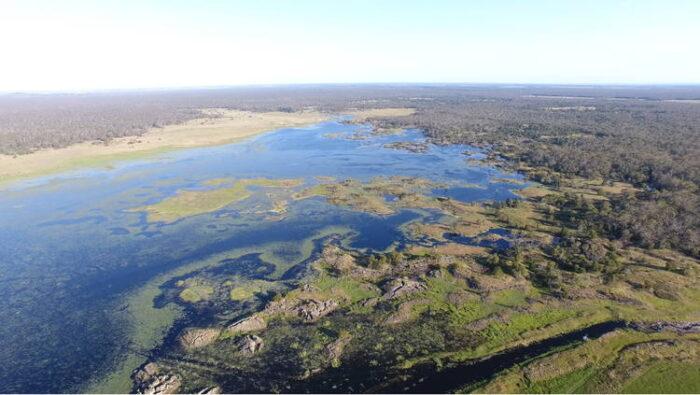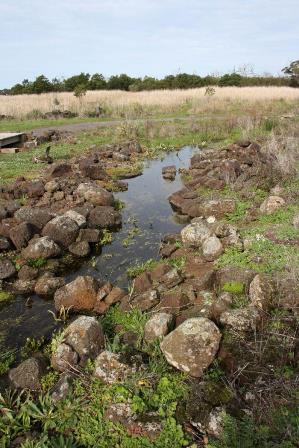Did you know that one of the oldest examples of aquaculture and hydraulic engineering is in Australia? In recognition of NAIDOC Week 2021, we are celebrating and recognizing the engineering achievements of Aboriginal and Torres Strait Islander peoples.

The Budj Bim Cultural Landscape is located in the traditional Country of the Gunditjmara Aboriginal people in south-eastern Australia. The landscape comprises three components; Budj Bim (northern) component, Kurtonitj (central) component, and Tyrendarra (southern) component.
The Gunditjmara people have called the lands of Australia home for tens of thousands of years, from the time the now-dormant volcano of Mount Eccles was erupting to the present day.
They used the land’s natural topography and features to establish settlements and villages near natural bodies of water, with the community’s population believed to be in the thousands.
Gunditjmara Aquaculture System
Carbon dated to be around 6,600 years old, the Gunditjmara people created a complex aquaculture network where modified channels diverted water and kooyang (short-finned eel) into holding ponds. Volcanic rock was used to construct a sophisticated stone aquaculture complex of fish traps, weirs, dams, and channels.
Here, kooyang were able to grow fat and be harvested with woven baskets built from wood lattice structures. This provided a year-round food supply for the Gunditjmara people and was also important for trade.
The extraordinary network is spread around an area of about one hundred square kilometers, in the vicinity of Lake Condah. At the center of this region is the extinct Budj Bim volcano. When the Europeans arrived, it was renamed Mount Eccles, but the mountain is commonly regarded by its original Gunditjmara name.
For the Gunditjmara people, the mountain is spiritually significant. They believe that the features of the surrounding native landscape mark out the traces of the creator, Budj Bim, who emerged in the form of the volcano. The eruptions, which occurred an estimated 30,000 years ago, disrupted the drainage system of the region. This left behind a vast landscape of abundant swamps and wetlands. The increased presence of eels and fish enabled the Aboriginal people to develop into a settled society.
The aquaculture system provided an economic and social base for Gunditjmara society. This interrelationship of Gunditjmara cultural and environmental systems is documented through present-day Gunditjmara cultural knowledge, practices, material culture, research, and historical documents.

World Heritage Listing
In August 2019, the Budj Bim Cultural Landscape was inscribed on UNESCO’s World Heritage List for its Outstanding Universal Value. This was a landmark decision as it is one of the few places recognized purely for its importance to the First Nations People.
The decision came following a campaign that stretched back more than a decade and was a monumental moment in recognizing the sensitive way in which the Gunditjmara people had lived in harmony with the landscape.
“This is a very special day for our community”, elder Denise Lovett said in a statement. “This landscape, which we have cared for over thousands of years, is so important to Gunditjmara People,”
“The decision also recognizes Budj Bim’s significance to all of humanity. We are so proud to now be able to share our achievements and story with the world.”
Lessons in Sustainability
The colonization of Australia had a devastating impact on Indigenous people, who have lived on this land for thousands of years. Thousands of First Nations people were massacred, hundreds of plant and animal species went extinct, waterways were destroyed, resources were taken out of the ground, and the ecology drastically changed in a rapid amount of time.
The theme for NAIDOC Week 2021 is Heal Country! It calls for stronger measures to recognize, protect, and maintain all aspects of Aboriginal and Torres Strait Islander culture and heritage. Heal Country! highlights the greater need for the protection of Aboriginal and Torres Strait Islander lands and waters, sacred sites, and cultural heritage from exploitation, desecration, and destruction.
Whilst the adding of the Budj Bim Cultural Landscape to the World Heritage List allowed for increased protection, there are still many outstanding injustices that need resolving. Healing country is about the historical, political, and administrative landscapes adapting to further empower and celebrate Aboriginal and Torres Strait Islander communities, nations, and heritage.
The eye-opening achievements of the Gunditjmara people are an incredible insight into more sustainable ways of interacting with the natural world. Whilst the system highlights an inspiring engineering accomplishment, it shows how the Gunditjmara people worked with the land without disrupting the natural landscape.
Country is our healing and we all benefit from living on land that is healthy and well-cared for. So much has been taken and it is now time to give back to Country.
For more information about NAIDOC Week or this year’s theme, head to the official NAIDOC website.



